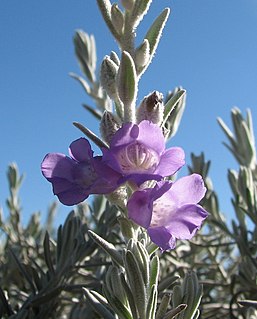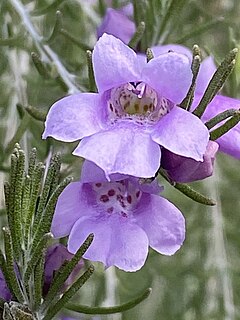
Eremophila nivea, commonly known as silky eremophila, is a flowering plant in the figwort family, Scrophulariaceae and is endemic to Western Australia. In nature it is a rare shrub with hairy branches and leaves, and blue, purple or violet flowers.

Eremophila microtheca, also known as heath-like eremophila, is a flowering plant in the figwort family, Scrophulariaceae and is endemic to Western Australia. It is an erect shrub with densely hairy branches and leaves, narrow leaves and pale lilac-coloured flowers and which emits a strong odour.

Eremophila compressa is a flowering plant in the figwort family, Scrophulariaceae and is endemic to a small area in the south west of Western Australia. It is an erect shrub whose leaves have 2 or 3 prominent teeth near their ends, and white or cream-coloured flowers.
Eremophila grandiflora is a flowering plant in the figwort family, Scrophulariaceae and is endemic to Western Australia. It is a large shrub with shiny leaves and the largest flowers in its genus and is only known from a restricted area near Paynes Find.
Eremophila koobabbiensis, commonly known as Koobabbie eremophila, is a flowering plant in the figwort family, Scrophulariaceae and is endemic to Western Australia. It is an erect shrub with hairy branches, pale green leaves and lilac to pale mauve flowers. It is only known from a single farm where there were 96 mature plants in 2010, but specimens grown from cuttings survive in Victoria (Australia) and South Australia, as well as in Kings Park, Perth.
Eremophila pallida is a flowering plant in the figwort family, Scrophulariaceae and is endemic to Western Australia. It is a small, spreading shrub with hairy stems, leaves with a few serrations and reddish purple to violet flowers.
Eremophila buirchellii is a flowering plant in the figwort family, Scrophulariaceae and is endemic to the Mount Augustus National Park in Western Australia. It is an erect shrub with densely clustered leaves, pink, bell-shaped flowers and with most parts of the plant covered with greyish, branched hairs.
Eremophila ballythunnensis is a flowering plant in the figwort family, Scrophulariaceae and is endemic to Western Australia. It is a small, spreading shrub with narrow oval leaves and mauve-purple flowers with densely hairy sepals.
Eremophila daddii is a flowering plant in the figwort family, Scrophulariaceae and is endemic to Western Australia. It is a large shrub with sticky branches, hairy leaves and brown and cream-coloured flowers blotched with purple.
Eremophila ferricola is a flowering plant in the figwort family, Scrophulariaceae and is endemic to Western Australia. It is an erect shrub with lance-shaped leaves and yellowish brown to greenish yellow flowers covered with fine hairs. The species is only known from a single location, growing on a banded ironstone hill.
Eremophila hamulata is a flowering plant in the figwort family, Scrophulariaceae and is endemic to Western Australia. It is an erect, woody shrub with sticky branches, narrow, hooked leaves and hairy mauve-purple flowers.
Eremophila jamesiorum is a flowering plant in the figwort family, Scrophulariaceae and is endemic to Western Australia. It is a wispy, sticky shrub with narrow linear leaves and white flowers tinged with pink or mauve. It is only known from a few locations in the Gibson Desert.
Eremophila pusilliflora is a flowering plant in the figwort family, Scrophulariaceae and is endemic to Western Australia. It is a low, open shrub with narrow egg-shaped leaves and flowers which vary in colour from red to cream with a red tinge. It grows in the Pilbara region.
Eremophila laccata is a flowering plant in the figwort family, Scrophulariaceae and is endemic to an area near Carnegie in Western Australia. It is a small, low, spindly shrub with scattered, linear leaves, and pink, flattened bell-shaped flowers.
Eremophila subangustifolia is a flowering plant in the figwort family, Scrophulariaceae and is endemic to the south-west of Western Australia. It is a highly branched shrub which produces a slightly unpleasant odour and has its younger parts densely covered with greyish hairs. The leaves are scattered along the branches and the mostly white flowers are borne singly in leaf axils. It only occurs in a small area near Eneabba and had previously been known as E. microtheca subsp. 'narrow leaves'.
Eremophila regia is low-growing shrub with pink to red flowers, small thread-like leaves and that is endemic to Western Australia. It grows on rocky hilltops in the Princess Ranges.
Eremophila resiliens is a low-growing shrub with deep reddish purple flowers, woolly hairy leaves and that is endemic to Western Australia. It grows on slopes and breakaways near Lake Carnegie.
Eremophila scrobiculata is low, spreading shrub with sessile, linear leaves and lilac-coloured flowers and that is endemic to Western Australia. It grows on the slopes of low, stony hills on Wanna Station.
Eremophila victoriae is small shrub with sessile, egg-shaped leaves and purple flowers and that is endemic to Western Australia. It is only known from two populations in the Great Victoria Desert.
Eremophila yinnetharrensis is a species of flowering plant in the family Scrophulariaceae and is endemic to a restricted area of Western Australia. It is an erect, wispy shrub with sessile, lance-shaped leaves with the narrower end towards the base and purple flowers. It is only known from near Yinnetharra Station in the Gascoyne region.



